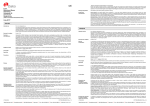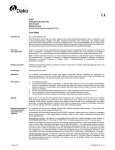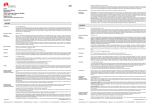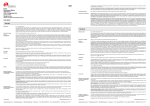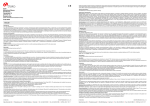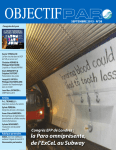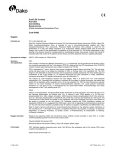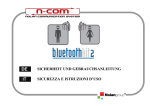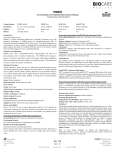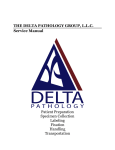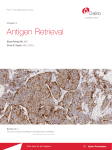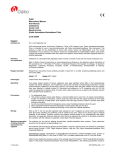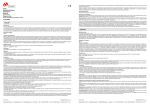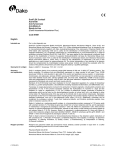Download Monoclonal Mouse
Transcript
FLEX Monoclonal Mouse Anti-Human Melanosome Clone HMB45 Ready-to-Use (Dako Autostainer/Autostainer Plus) Code IS052 English Intended use For in vitro diagnostic use. FLEX Monoclonal Mouse Anti-Human Melanosome, Clone HMB45, Ready-to-Use, (Dako Autostainer/Autostainer Plus), is intended for use in immunohistochemistry together with Dako Autostainer/Autostainer Plus instruments. This antibody is useful for the identification of melanocytes with immature melanosome formation in normal skin, nevus, and melanoma tissue. Positive results aid in the classification of melanomas and melanocytic lesions and also aid in distinguishing metastatic amelanotic melanomas from other poorly differentiated tumors of uncertain origin. Differential identification is aided by the results from a panel of antibodies. The clinical interpretation of any staining or its absence should be complemented by morphological studies using proper controls and should be evaluated within the context of the patient's clinical history and other diagnostic tests by a qualified pathologist. Summary and explanation Anti-melanosome, HMB45 has been shown to react with a 10 kDa segment of a neuraminidase-sensitive sialylated glycoconjugate present in pre- and early-stage (immature) melanosomes (2-4). Refer to Dako’s General Instructions for Immunohistochemical Staining or the detection system instructions of IHC procedures for: 1) Principle of Procedure, 2) Materials Required, Not Supplied, 3) Storage, 4) Specimen Preparation, 5) Staining Procedure, 6) Quality Control, 7) Troubleshooting, 8) Interpretation of Staining, 9) General Limitations. Reagent provided Ready-to-use monoclonal mouse antibody provided in liquid form in a buffer containing stabilizing protein and 0.015 mol/L NaN3. Clone: HMB45 Isotype: IgG1, kappa Immunogen Extract of pigmented melanoma metastases from lymph nodes Specificity The presence of the antigen indicates active melanosome formation and thus melanocytic differentiation (5). It is also expressed in normal fetal melanocytes (2,3), but not in normal resting adult melanocytes, regardless of the degree of pigmentation (1,3,6). Upon activation, adult melanocytes can re-express the HMB45-defined antigen (as it is expressed in fetal melanocytes). Such melanocytes are activated by a variety of stimuli. For example, HMB45-positive cells have been detected in tissue overlying or adjacent to granulation tissue, hemangiomas, vessel-rich tumor stroma, and basal cell carcinoma (5-8). Hair follicles stain occasionally due to associated stimulated melanocytes (1). Positive HMB45 staining has not been observed with melanocytes in lentigines or overlying fibroblastic proliferations such as keloids, dermatofibromas and old fibrotic hemangiomas (8). Nonmelanocytic normal tissues do not react with the HMB45 antibody. Precautions 1. For professional users. 2. This product contains sodium azide (NaN3), a chemical highly toxic in pure form. At product concentrations, though not classified as hazardous, sodium azide may react with lead and copper plumbing to form highly explosive build-ups of metal azides. Upon disposal, flush with large volumes of water to prevent metal azide build-up in plumbing. 3. As with any product derived from biological sources, proper handling procedures should be used. 4. Wear appropriate Personal Protective Equipment to avoid contact with eyes and skin. 5. Unused solution should be disposed of according to local, State and Federal regulations. Storage Store at 2-8 °C. Do not use after expiration date stamped on vial. If reagents are stored under any conditions other than those specified, the conditions must be verified by the user. There are no obvious signs to indicate instability of this product. Therefore, positive and negative controls should be run simultaneously with patient specimens. If unexpected staining is observed which cannot be explained by variations in laboratory procedures and a problem with the antibody is suspected, contact Dako Technical Support. Specimen preparation including materials required but not supplied The antibody can be used for labeling formalin-fixed, paraffin-embedded tissue sections. Tissue specimens should be cut into sections of approximately 4 µm. (115366-001) Pre-treatment with heat-induced epitope retrieval (HIER) is required. Optimal results are obtained by pretreating tissues using EnVision FLEX Target Retrieval Solution, High pH (10x) (Dako Autostainer/Autostainer Plus) (Code K8010/K8014). 307120EFG_001 p. 1/7 Deparaffinized sections: Pre-treatment of deparaffinized formalin-fixed, paraffin-embedded tissue sections is recommended using Dako PT Link (Code PT100/PT101). For details, please refer to the PT Link User Guide. Follow the pre-treatment procedure outlined in the package insert for EnVision FLEX Target Retrieval Solution, High pH (10x) (Dako Autostainer/Autostainer Plus) (Code K8010/K8014). The following parameters should be used for PT Link: Pre-heat temperature: 65 °C; epitope retrieval temperature and time: 97 °C for 20 (±1) minutes; cool down to 65 °C. Rinse sections with diluted room temperature EnVision FLEX Wash Buffer (10x) (Dako Autostainer/Autostainer Plus) (Code K8010). Paraffin-embedded sections: As alternative specimen preparation, both deparaffinization and epitope retrieval can be performed in the PT Link using a modified procedure. See the PT Link User Guide for instructions. After the staining procedure has been completed, the sections must be dehydrated, cleared and mounted using permanent mounting medium. The tissue sections should not dry out during the treatment or during the following immunohistochemical staining procedure. For greater adherence of tissue sections to glass slides, the use of Dako Silanized Slides (Code S3003) is recommended. Staining procedure including materials required but not supplied The recommended visualization system is EnVision FLEX, High pH (Dako Autostainer/Autostainer Plus) (Code K8010). The staining steps and incubation times are pre-programmed into the software of Dako Autostainer/Autostainer Plus instruments, using the following protocols: Template protocol: FLEXRTU2 (200 uL dispense volume) or FLEXRTU3 (300 uL dispense volume) Autoprogram (without counterstaining): HMB45 or Autoprogram (with counterstaining): HMB45H The Auxiliary step should be set to “rinse buffer” in staining runs with ≤10 slides. For staining runs with >10 slides the Auxiliary step should be set to “none.” This ascertains comparable wash times. All incubation steps should be performed at room temperature. For details, please refer to the Operator’s Manual for the dedicated instrument. If the protocols are not available on the used Dako Autostainer instrument, please contact Dako Technical Services. Optimal conditions may vary depending on specimen and preparation methods, and should be determined by each individual laboratory. If the evaluating pathologist should desire a different staining intensity, a Dako Application Specialist/Technical Service Specialist can be contacted for information on re-programming of the protocol. Verify that the performance of the adjusted protocol is still valid by evaluating that the staining pattern is identical to the staining pattern described in “Performance characteristics.” Counterstaining in hematoxylin is recommended using EnVision FLEX Hematoxylin (Dako Autostainer/Autostainer Plus) (Code K8018). Non-aqueous, permanent mounting medium is recommended. Positive and negative controls should be run simultaneously using the same protocol as the patient specimens. The positive control tissue should include melanoma cells and the cells/structures should display reaction patterns as described for this tissue in “Performance characteristics” in all positive specimens. The recommended negative control reagent is FLEX Negative Control, Mouse (Dako Autostainer/Autostainer Plus) (Code IS750). Staining interpretation The cellular staining pattern is cytoplasmic. Performance characteristics Normal tissues: Normal adult tissues that exhibit positive staining with anti-melanosome, HMB45 include melanocytes (fetal and subset, melanocytes containing immature melanosomes), retinal pigment epithelia (prenatal and infantile). Negative tissues include adrenal gland, brain, breast, gallbladder, gastrointestinal tract, kidney, liver, lung, lymphoid tissue, mesenchymal cells, pancreas, peripheral nervous tissue, retinal pigment epithelia (adult), salivary gland, skin (melanocytes, normal resting, melanophages, Langerhans cells, keratinocytes, hair follicles, cutaneous nerves, sweat glands, sebaceous) and testis. Abnormal tissues: Anti-melanosome, HMB45 stains 245/256 (95.7%) of melanoma (excluding desmoplastic) (1,3,5,6,9-14) and 245/291 (84.2%) of melanoma (including desmoplastic) (1,3,5,6,9,13-14). Melanocytic atypical hyperplasia (2/2) (1), melanocytic neuroectoderm of infancy (1/1) (6), renal angiomyolipoma (27/29) (11,12) and various nevi (218/228) (1,5,6,10) are stained by anti-melanoma, HMB45. (115366-001) 307120EFG_001 p. 2/7 Français Réf. IS052 Utilisation prévue Pour utilisation diagnostique in vitro. FLEX Monoclonal Mouse Anti-Human Melanosome, clone HMB45, Ready-to-Use, (Dako Autostainer/Autostainer Plus), est destiné à une utilisation en immunohistochimie avec les instruments Dako Autostainer/Autostainer Plus. Cet anticorps est utile pour l’identification des mélanocytes avec une formation immature du mélanosome dans les tissus de peau sains, les nævi et les mélanomes. Des résultats positifs facilitent la classification des mélanomes et des lésions mélanocytaires et permettent également de distinguer les mélanomes métastatiques non mélaniques d’autres tumeurs mal différenciées d’origine incertaine. L’identification différentielle est facilitée par les résultats provenant d’un panel d’anticorps. L’interprétation clinique de toute coloration ou son absence doit être complétée par des études morphologiques en utilisant des contrôles appropriés et doit être évaluée en fonction des antécédents cliniques du patient et d’autres tests diagnostiques par un pathologiste qualifié. Résumé et explication L’anti-mélanosome, HMB45 réagit à un segment de 10 kDa d'un glycoconjugué sialylaté sensible à la neuraminidase présent dans les pré-mélanosomes et les mélanosomes précoces (immatures) (2-4). Se référer aux Instructions générales de coloration immunohistochimique de Dako ou aux instructions du système de détection relatives aux procédures IHC pour plus d’informations concernant les points suivants : 1) Principe de procédure, 2) Matériels requis mais non fournis, 3) Conservation, 4) Préparation des échantillons, 5) Procédure de coloration, 6) Contrôle qualité, 7) Dépannage, 8) Interprétation de la coloration, 9) Limites générales. Réactifs fournis Anticorps monoclonal de souris prêt à l’emploi fourni sous forme liquide dans un tampon contenant une protéine stabilisante et 0,015 mol/L d’azide de sodium. Clone : HMB45 Isotype : IgG1, kappa Immunogène Extrait de métastases pigmentées de mélanome prélevées sur des ganglions lymphatiques Spécificité La présence de l’antigène indique la formation active de mélanosomes et donc une différenciation mélanocytaire (5). Il est également exprimé dans les mélanocytes fœtaux sains (2,3), mais pas dans les mélanocytes adultes au repos, quel que soit le degré de pigmentation (1,3,6). Sous l’activation, les mélanocytes adultes peuvent réexprimer l’antigène défini par HMB45 (tel qu’il est exprimé dans les mélanocytes fœtaux). Ces mélanocytes sont activés par divers stimuli. Par exemple, des cellules positives au HMB45 ont été détectées dans des tissus recouvrant ou adjacents au tissu de granulation, aux hémangiomes, au stroma de tumeurs riches en vaisseaux, et au carcinome des cellules basales (5-8). Les follicules pileux se colorent occasionnellement en raison des mélanocytes stimulés associés (1). Aucune coloration positive au HMB45 n’a été observée dans les mélanocytes des lentigines ou dans les proliférations fibroblastiques recouvrantes telles que les chéloïdes, les dermatofibromes et les hémangiomes fibreux anciens (8). Les tissus sains non mélanocytaires ne réagissent pas à l'anticorps HMB45. Précautions 1. Pour utilisateurs professionnels. 2. Ce produit contient de l’azide de sodium (NaN3), produit chimique hautement toxique dans sa forme pure. Aux concentrations du produit, bien que non classé comme dangereux, l’azide de sodium peut réagir avec le cuivre et le plomb des canalisations et former des accumulations d’azides métalliques hautement explosifs. Lors de l’élimination, rincer abondamment à l’eau pour éviter toute accumulation d’azide métallique dans les canalisations. 3. Comme avec tout produit d’origine biologique, des procédures de manipulation appropriées doivent être respectées. 4. Porter un vêtement de protection approprié pour éviter le contact avec les yeux et la peau. 5. Les solutions non utilisées doivent être éliminées conformément aux réglementations locales et nationales. Conservation Conserver entre 2 et 8 °C. Ne pas utiliser après la date de péremption imprimée sur le flacon. Si les réactifs sont conservés dans des conditions autres que celles indiquées, celles-ci doivent être validées par l’utilisateur. Il n’y a aucun signe évident indiquant l’instabilité de ce produit. Par conséquent, des contrôles positifs et négatifs doivent être testés en même temps que les échantillons de patient. Si une coloration inattendue est observée, qui ne peut être expliquée par un changement des procédures du laboratoire, et en cas de suspicion d’un problème lié à l’anticorps, contacter l’assistance technique de Dako. Préparation des échantillons y compris le matériel requis mais non fourni L’anticorps peut être utilisé pour le marquage des coupes de tissus inclus en paraffine et fixés au formol. L'épaisseur des coupes d'échantillons de tissu doit être d’environ 4 µm. Le prétraitement avec un démasquage d’épitope induit par la chaleur (HIER) est nécessaire. Des résultats optimaux sont obtenus en prétraitant les tissus à l’aide de la EnVision FLEX Target Retrieval Solution, High pH (10x), (Dako Autostainer/Autostainer Plus) (Réf. K8010/K8014). Coupes déparaffinées : Le pré-traitement des coupes de tissus déparaffinés fixés au formol et inclus en paraffine est recommandé à l’aide du Dako PT Link (Réf. PT100/PT101). Pour plus de détails, se référer au Guide d’utilisation du PT Link. (115366-001) 307120EFG_001 p. 3/7 Suivre la procédure de pré-traitement indiquée dans la notice pour la EnVision FLEX Target Retrieval Solution, High pH (10x), (Dako Autostainer/Autostainer Plus) (Réf. K8010/K8014). Les paramètres suivants doivent être utilisés pour le PT Link : Température de préchauffage : 65 °C; température et durée de restauration de l’épitope : 97 °C pour 20 (±1) minutes ; laisser refroidir jusqu’à 65 °C. Rincer les coupes avec un EnVision FLEX Wash Buffer (10x), dilué à température ambiante (Dako Autostainer/Autostainer Plus) (Réf. K8010). Coupes incluses en paraffine : Comme préparation alternative des échantillons, le déparaffinage et la restauration de l’épitope peuvent être réalisés dans le PT Link à l’aide d’une procédure modifiée. Se référer aux instructions du Guide d’utilisation du PT Link. Une fois que la procédure de coloration est terminée, les coupes doivent être déshydratées, lavées et montées à l’aide d’un milieu de montage permanent. Les coupes de tissus ne doivent pas sécher lors du traitement ou lors de la procédure de coloration immunohistochimique suivante. Pour une meilleure adhérence des coupes de tissus sur les lames de verre, il est recommandé d’utiliser des lames Dako Silanized Slides (Réf. S3003). Procédure de coloration y compris le matériel requis mais non fourni Le système de visualisation recommandé est le EnVision FLEX, High pH, (Dako Autostainer/Autostainer Plus) (Réf. K8010). Les étapes de coloration et d’incubation sont préprogrammées dans le logiciel des instruments Dako Autostainer/Autostainer Plus, à l’aide des protocoles suivants : Protocole modèle : FLEXRTU2 (volume de distribution de 200 µl) ou FLEXRTU3 (volume de distribution de 300 µl) Autoprogram (sans contre-coloration) : HMB45 ou Autoprogram (avec contre-coloration) : HMB45H L’étape Auxiliary doit être réglée sur « rinse buffer » lors des cycles de coloration avec ≤10 lames. Pour les cycles de coloration de >10 lames, l’étape Auxiliary doit être réglée sur « none ». Cela confirme des temps de lavage comparables. Toutes les étapes d’incubation doivent être effectuées à température ambiante. Pour plus de détails, se référer au Manuel de l’opérateur spécifique à l'instrument. Si les protocoles ne sont pas disponibles sur l’instrument Dako Autostainer utilisé, contacter le service technique de Dako. Les conditions optimales peuvent varier en fonction du prélèvement et des méthodes de préparation, et doivent être déterminées par chaque laboratoire individuellement. Si le pathologiste qui réalise l’évaluation désire une intensité de coloration différente, un spécialiste d’application/spécialiste du service technique de Dako peut être contacté pour obtenir des informations sur la re-programmation du protocole. Vérifier que l'exécution du protocole modifié est toujours valide en vérifiant que le schéma de coloration est identique au schéma de coloration décrit dans les « Caractéristiques de performance ». Il est recommandé d’effectuer une contre-coloration à l’aide d’hématoxyline EnVision FLEX Hematoxylin, (Dako Autostainer/Autostainer Plus) (Réf. K8018). L’utilisation d’un milieu de montage permanent non aqueux est recommandée. Des contrôles positifs et négatifs doivent être réalisés en même temps et avec le même protocole que les échantillons du patient. Le contrôle de tissu positif doit comprendre les cellules de mélanome et les cellules/structures doivent présenter des schémas de réaction tels que décrits pour ces tissus dans les « Caractéristiques de performance » pour tous les échantillons positifs. Le contrôle négatif recommandé est le FLEX Negative Control, Mouse, (Dako Autostainer/Autostainer Plus) (Réf. IS750). Interprétation de la coloration Le schéma de coloration cellulaire est cytoplasmique. Caractéristiques de performance Tissus sains : Les tissus sains présentant une coloration positive à l’anti-mélanosome, HMB45 incluent les mélanocytes (mélanocytes fœtaux et sous-groupes contenant des mélanosomes immatures), l’épithélium pigmentaire rétinien (chez le fœtus et l’enfant). Les tissus négatifs sont les suivants : glande surrénale, cerveau, sein, vésicule biliaire, appareil digestif, rein, foie, poumon, tissu lymphoïde, cellules mésenchymateuses, pancréas, tissu nerveux périphérique, épithélium pigmentaire rétinien (adulte), glande salivaire, peau (mélanocytes normaux au repos, mélanophages, îlots de Langerhans, kératinocytes, follicules pileux, nerfs cutanés, glandes sudoripares et sébacées) et testicule. Tissus tumoraux : L’anti-mélanosome, HMB45 colore 245 cas sur 256 (95,7 %) de mélanomes (excepté les mélanomes desmoplastiques) (1,3,5,6,9-14) et 245 cas sur 291 (84,2 %) de mélanomes (y compris les mélanomes desmoplastiques) (1,3,5,6,9,13-14). L’hyperplasie mélanocytaire atypique (2/2) (1), le neuroectoderme mélanocytaire infantile (1/1) (6), l’angiomyolipome rénal (27/29) (11,12) et différents nævi (218/228) (1,5,6,10) sont colorés par l’anti-mélanome, HMB45. (115366-001) 307120EFG_001 p. 4/7 Deutsch Code-Nr. IS052 Zweckbestimmung Zur In-vitro-Diagnostik. FLEX Monoclonal Mouse Anti-Human Melanosome, Clone HMB45, Ready-to-Use, (Dako Autostainer/Autostainer Plus) ist zur Verwendung in der Immunhistochemie in Verbindung mit Dako Autostainer/Autostainer Plus-Geräten bestimmt. Dieser Antikörper dient zur Identifizierung von Melanozyten mit unreifer Melanosombildung in gesunder Haut, Nävuszellen und melanomem Gewebe. Positive Ergebnisse unterstützten sowohl die Klassifizierung von Melanomen und melanozytische Läsionen als auch die Differenzierung amelanotischer Melanommetastasen von anderen schwach differenzierten Tumoren, deren Ursprung unsicher ist. Die Differenzialdiagnose wird durch die Ergebnisse eines Antikörper-Panels unterstützt. Die klinische Auswertung einer eventuell eintretenden Färbung sollte durch morphologische Studien mit ordnungsgemäßen Kontrollen ergänzt werden und von einem qualifizierten Pathologen unter Berücksichtigung der Krankengeschichte und anderer Diagnostiktests des Patienten vorgenommen werden. Zusammenfassung und Erklärung Anti-Melanosom, HMB45 reagiert nachweislich mit einem 10 kDa großen Segment eines Neuroaminidaseempfindlichen, in Vor- und Frühstadien (unreifer) Melanosome vorhandenen sialylierten Glykokonjugats (2–4). Folgende Angaben bitte den Allgemeinen Richtlinien zur immunhistochemischen Färbung von Dako oder den Anweisungen des Detektionssystems für IHC-Verfahren entnehmen: 1) Verfahrensprinzip, 2) Erforderliche, aber nicht mitgelieferte Materialien, 3) Aufbewahrung, 4) Vorbereitung der Probe, 5) Färbeverfahren, 6) Qualitätskontrolle, 7) Fehlersuche und -behebung, 8) Auswertung der Färbung, 9) Allgemeine Beschränkungen. Geliefertes Reagenz Gebrauchsfertiger, monoklonaler Maus-Antikörper in flüssiger Form in einem Puffer, der stabilisierendes Protein und 0,015 mol/L NaN3 enthält. Klon: HMB45 Isotyp: IgG1, Kappa Immunogen Extrakt pigmentierter Melanommetastasen aus Lymphknoten Spezifität Das Vorliegen des Antigens ist ein Anzeichen für die aktive Melanosombildung und somit Melanozytendifferenzierung (5). Es wird ebenfalls in gesunden fötalen Melanozyten exprimiert (2,3), nicht aber in gesunden, ruhenden adulten Melanozyten, unabhängig vom Pigmentierungsgrad (1,3,6). Nach Aktivierung können adulte Melanozyten (ebenso wie fötale Melanozyten) das HMB45-definierte Antigen erneut exprimieren. Die Aktivierung dieser Melanozyten erfolgt durch unterschiedliche Stimuli. So wurden beispielsweise HMB45positive Zellen in Granulationsgewebe überlagernden oder daran angrenzenden Geweben, in Hämangiomen, gefäßreichem Tumorstroma und Basalzellenkarzinomen nachgewiesen (5–8). Gelegentlich färben sich Haarfollikel aufgrund benachbarter stimulierter Melanozyten (1). Bei Melanozyten in Muttermalen oder überlagernden fibroblastischen Proliferationen wie Keloiden, Dermatofibromen und alten fibrotischen Hämangiomen kam es nicht zur positiven HMB45-Färbung (8). Gesunde, nicht-melanozytische Gewebe reagieren nicht mit dem HMB45-Antikörper. Vorsichtsmaßnahmen 1. Nur für Fachpersonal bestimmt. 2. Dieses Produkt enthält Natriumazid (NaN3), eine in reiner Form äußerst giftige Chemikalie. Natriumazid kann auch in als ungefährlich eingestuften Konzentrationen mit Blei- und Kupferrohren reagieren und hochexplosive Metallazide bilden. Nach der Entsorgung stets mit viel Wasser nachspülen, um Metallazidansammlungen in den Leitungen vorzubeugen. 3. Wie alle Produkte biologischen Ursprungs müssen auch diese entsprechend gehandhabt werden. 4. Geeignete Schutzkleidung tragen, um Augen- und Hautkontakt zu vermeiden. 5. Nicht verwendete Lösung ist entsprechend örtlichen, bundesstaatlichen und staatlichen Richtlinien zu entsorgen. Lagerung Bei 2–8 °C aufbewahren. Nach Ablauf des auf dem Fläschchen aufgedruckten Verfalldatums nicht mehr verwenden. Werden die Reagenzien unter anderen als den angegebenen Bedingungen aufbewahrt, müssen diese Bedingungen vom Benutzer validiert werden. Es gibt keine offensichtlichen Anzeichen für eine eventuelle Produktinstabilität. Positiv- und Negativkontrollen sollten daher zur gleichen Zeit wie die Patientenproben getestet werden. Falls es zu einer unerwarteten Färbung kommt, die sich nicht durch Unterschiede bei Laborverfahren erklären lässt und auf ein Problem mit dem Antikörper hindeutet, ist der technische Kundendienst von Dako zu verständigen. Vorbereitung der Probe und erforderliche, aber nicht mitgelieferte Materialien Der Antikörper eignet sich zur Markierung von formalinfixierten und paraffineingebetteten Gewebeschnitten. Gewebeproben sollten in Schnitte von ca. 4 µm Stärke geschnitten werden. Die Vorbehandlung durch hitzeinduzierte Epitopdemaskierung (HIER) ist erforderlich. Optimale Ergebnisse können durch Vorbehandlung der Gewebe mit EnVision™ FLEX Target Retrieval Solution, High pH (10x), (Dako Autostainer/Autostainer Plus) (Code-Nr. K8010/K8014) erzielt werden. Entparaffinierte Schnitte: Die Vorbehandlung der entparaffinierten, formalinfixierten, paraffineingebetteten Gewebeschnitte sollte mit Dako PT Link (Code-Nr. PT100/PT101) erfolgen. Weitere Informationen hierzu siehe PT Link-Benutzerhandbuch. (115366-001) 307120EFG_001 p. 5/7 Vorbehandlung gemäß der Beschreibung in der Packungsbeilage für EnVision™ FLEX Target Retrieval Solution, High pH (10x) (Dako Autostainer/Autostainer Plus) (Code-Nr. K8010/K8014) durchführen. Für PT Link sollten die folgenden Parameter verwendet werden: Vorwärmtemperatur: 65 °C; Temperatur und Zeit für Epitopdemaskierung: 97 °C für 20 (±1) Minuten; auf 65 °C abkühlen lassen. Schnitte mit auf Raumtemperatur gebrachtem, verdünntem EnVision™ FLEX Wash Buffer (10x) (Dako Autostainer/Autostainer Plus) (Code-Nr. K8010) abspülen. Paraffineingebettete Schnitte: Zur Probenpräparation kann für Entparaffinierung und Epitopdemaskierung im PT Link auch ein modifiziertes Verfahren verwendet werden. Weitere Informationen siehe PT LinkBenutzerhandbuch. Nach Abschluss des Färbeverfahrens müssen die Schnitte dehydriert, geklärt und unter Verwendung eines permanenten Fixiermittels auf die Objektträger aufgebracht werden. Die Gewebeschnitte dürfen während der Behandlung oder während des anschließenden immunhistochemischen Färbeverfahrens nicht austrocknen. Zur besseren Haftung der Gewebeschnitte an den Glasobjektträgern wird die Verwendung von Dako Silanized Slides (Code-Nr. S3003) empfohlen. Färbeverfahren und erforderliche, aber nicht mitgelieferte Materialien Das empfohlene Visualisierungssystem ist EnVision™ FLEX, High pH (Dako Autostainer/Autostainer Plus) (Code-Nr. K8010). Die Färbeschritte und Inkubationszeiten sind in der Software der Dako Autostainer/Autostainer Plus-Geräte mit den folgenden Protokollen vorprogrammiert: Matrix-Protokoll: FLEXRTU2 (200 µl Abgabevolumen) oder FLEXRTU3 (300 µl Abgabevolumen) Autoprogram (ohne Gegenfärbung): HMB45 oder Autoprogram (mit Gegenfärbung): HMB45H Bei Färbedurchläufen mit höchstens 10 Objektträgern sollte der „Zusatz“-Schritt auf „Pufferspülgang“ eingestellt werden. Für Färbedurchläufe mit mehr als 10 Objektträgern den „Zusatz“-Schritt auf „Keine“ einstellen. Dieses gewährleistet vergleichbare Waschzeiten. Alle Inkubationsschritte sollten bei Raumtemperatur durchgeführt werden. Nähere Einzelheiten bitte dem Benutzerhandbuch für das jeweilige Gerät entnehmen. Wenn die Färbeprotokolle auf dem verwendeten Dako Autostainer-Gerät nicht verfügbar sind, bitte den Technischen Kundendienst von Dako verständigen. Optimale Bedingungen können je nach Probe und Präparationsverfahren unterschiedlich sein und sollten vom jeweiligen Labor selbst ermittelt werden. Falls der beurteilende Pathologe eine andere Färbungsintensität wünscht, kann ein Anwendungsspezialist oder Kundendiensttechniker von Dako bei der Neuprogrammierung des Protokolls helfen. Die Leistung des angepassten Protokolls muss verifiziert werden, indem gewährleistet wird, dass das Färbemuster mit dem unter „Leistungsmerkmale“ beschriebenen Färbemuster identisch ist. Die Gegenfärbung in Hämatoxylin sollte mit EnVision™ FLEX Hematoxylin (Dako Autostainer/Autostainer Plus) (Code-Nr. K8018) ausgeführt werden. Empfohlen wird ein nichtwässriges, permanentes Fixiermittel. Positiv- und Negativkontrollen sollten zur gleichen Zeit und mit demselben Protokoll wie die Patientenproben getestet werden. Das positive Kontrollgewebe sollte Melanomzellen enthalten und die Zellen/Strukturen müssen in allen positiven Proben die für dieses Gewebe unter „Leistungsmerkmale“ beschriebenen Reaktionsmuster aufweisen. Das empfohlene Negativ-Kontrollreagenz ist FLEX Negative Control, Mouse, (Dako Autostainer/Autostainer Plus) (Code-Nr. IS750). Auswertung der Färbung Das zelluläre Färbemuster ist zytoplasmatisch. Leistungsmerkmale Gesundes Gewebe: Gesunde adulte Gewebe, die mit Anti-Melanosom, HMB45 eine positive Färbung zeigen, sind Melanozyten (fötale Formen und solche mit unreifen Melanosomen) sowie Netzhautpigmentepithel (pränatal und infantil). Negativ reagieren Nebennieren, Gehirn, Brust, Gallenblase, Verdauungstrakt, Nieren, Leber, Lunge, Lymphgewebe, Mesenchymzellen, Pankreas, peripheres Nervengewebe, Netzhautpigmentepithel (adult), Speicheldrüsen, Haut (Melanozyten, gesunde ruhende Zellen, Melanophagen, Langerhans’sche Zellen, Keratinozyten, Haarfollikel, Hautnerven, Schweiß- und Talgdrüsen) sowie Hoden. Pathologisches Gewebe: Anti-Melanosom, HMB45 färbte 245 von 256 (95,7 %) der Melanome (ausgenommen desmoplastische Formen) (1, 3, 5, 6, 9–14) und 245 von 291 (84,2 %) der Melanome (einschließlich desmoplastische Formen) (1, 3, 5, 6, 9, 13–14). Auch atypische melanozytische Hyperplasie (2 von 2) (1), melanozytisches Neuroektoderm im Kindesalter (1 von 1) (6), Nieren-Angiomyolipome (27 von 29) (11,12) und verschiedene Nävi (218 von 228) (1,5,6,10) wurden durch Anti-Melanosom HMB45 gefärbt. (115366-001) 307120EFG_001 p. 6/7 References Bibliographie Literaturangaben 1. Gown AM, Vogel AM. Monoclonal antibodies to intermediate filament proteins of human cells: Unique and cross-reacting antibodies. J Cell Biol 1982; 95:414 2. Kapur RP, Bigler SA, Skelly M, Gown AM. Anti-melanoma monoclonal antibody HMB45 identifies an oncofetal glycoconjugate associated with immature melanosomes. J Histochem Cytochem 1992; 40(2):207 3. Esclamado RM, Gown AM, Vogel AM. Unique proteins defined by monoclonal antibodies specific for human melanoma. Amer J Surg 1986; 152:376 4. Taatjes DJ, Arendash-Durand B, von Turkovich M, Trainer TD. HMB-45 antibody demonstrates melanosome specificity by immunoelectron microscopy. Arch Pathol Lab Med 1993; 117:264 5. Skelton HG, Smith KJ, Barrett TL, Lupton GP, Graham JH. HMB-45 staining in benign and malignant melanocytic lesions. Amer J Dermatopathol 1991; 13:543 6. Colombari R, Bonetti F, Zamboni G, Scarpa A, Marino F, Tomezzoli A, Capelli P, Menestrina F, Chilosi M, Fiore-Donati L. Distribution of melanoma specific antibody (HMB-45) in benign and malignant melanocytic tumors. Virch Arch A Pathol Anat 1988; 413:17 7. Smoller BR, Hsu A, Krueger J. HMB-45 monoclonal antibody recognizes an inducible and reversible melanocyte cytoplasmic protein. J Cutan Pathol 1991; 18:315 8. Smoller BR, McNutt NS, Hsu A. HMB-45 recognizes stimulated melanocytes. J Cutan Pathol 1989;16:49 9. Wick MR, Swanson PE, Rocamora A. Recognition of malignant melanoma by monoclonal antibody HMB-45. An immunohistochemical study of 200 paraffin-embedded cutaneous tumors. J Cutan Pathol 1988; 15:201 10. Ashfaq R, Weinberg AG, Albores-Saavedra J. Renal angiomyolipomas and HMB-45 reactivity. Canc 1993; 71:3091 11. Pea M, Bonetti F, Zamboni G, Martignoni G, Riva M, Colombari R, Mombello A, Bonzanini M, Scarpa A, Ghimenton C, Donati LF. Melanocyte-marker-HMB-45 is regularly expressed in angiomyolipoma of the kidney. Pathol 1991; 23:185 12. Bonetti F, Chiodera PL, Pea M, Martignoni G, Bosi F, Zamboni G, Mariuzzi GM. Transbronchial biopsy in lymphangiomyomatosis of the lung. HMB45 for diagnosis. Amer J Surg Pathol 1993; 17(11):1092 13. Ordonez NG, Xiaolong JI, Hickey RC. Comparison of HMB-45 monoclonal antibody and S-100 protein in the immunohistochemical diagnosis of melanoma. Amer J Clin Pathol 1988; 90(4):385 14. Bacchi CE, Goldfogel GA, Greer BE, Gown AM. Paget’s disease and melanoma of the vulva. Gyn Oncol 1992; 46:216 Edition 09/07 (115366-001) 307120EFG_001 p. 7/7







